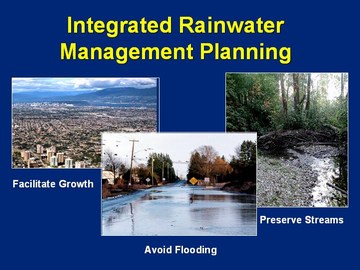Template for Integrated Stormwater Management Planning in the Metro Vancouver Region
Apply Land Use Planning Tools
Over the past decade, the term Integrated Stormwater Management Planning (ISMP) has gained widespread acceptance by local governments and the environmental agencies in British Columbia to describe a comprehensive, ecosystem-based approach to rainwater management. Local government typically has control over rainwater runoff in residential, commercial and industrial land uses. Thus, the purpose of an ISMP is to provide a clear picture of how to be proactive in applying land use planning tools to:
- Protect property from flooding; and
- Protect aquatic habitat from erosion and sedimentation.
“ Use of the term ISMP is unique to British Columbia. The City of Kelowna first used the term in 1998 to make a clear distinction between ‘suburban watershed management’ and the Province’s existing ‘integrated watershed management’ process for natural resource management in wilderness watersheds,” states Kim Stephens, Project Manager for Stormwater Planning: A Guidebook for British Columbia, released in June 2002.
Use of the term ISMP is unique to British Columbia. The City of Kelowna first used the term in 1998 to make a clear distinction between ‘suburban watershed management’ and the Province’s existing ‘integrated watershed management’ process for natural resource management in wilderness watersheds,” states Kim Stephens, Project Manager for Stormwater Planning: A Guidebook for British Columbia, released in June 2002.
For context on the history and evolution of ISMPs in British Columbia, refer to Chapter 1 in the Guidebook.
Metro Vancouver Template
Template for Integrated Stormwater Management Planning 2005 provides a standardized process that includes all of the key components for rainwater and stormwater management. These are categorized in terms of three disciplines – engineering, planning and environmental.
 “A municipality can decide which components are applicable, and can establish the level of effort required based on risk and local conditions. Not all of the components may be relevant for a given watershed or drainage catchment,” states Robert Hicks, Senior Engineer with Metro Vancouver, and Project Manager for template development.
“A municipality can decide which components are applicable, and can establish the level of effort required based on risk and local conditions. Not all of the components may be relevant for a given watershed or drainage catchment,” states Robert Hicks, Senior Engineer with Metro Vancouver, and Project Manager for template development.
The ISMP Template is nested within Chapter 9 of Stormwater Planning: A Guidebook for British Columbia



